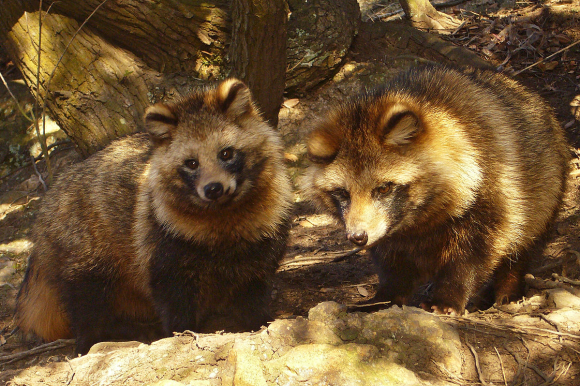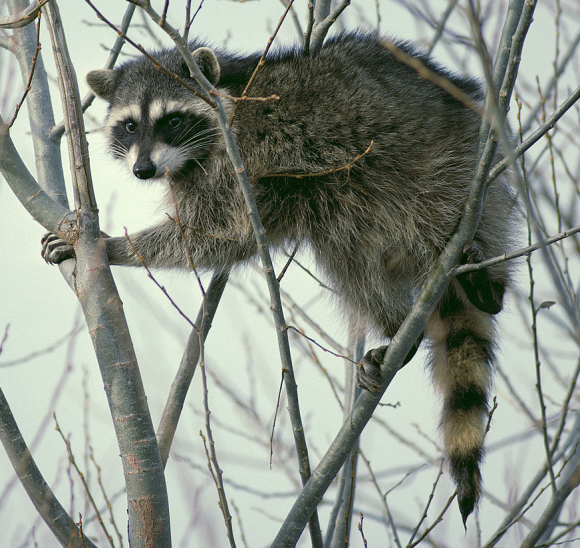
They may look similar at first glance, but the two separate species of forest critters have a handful of key differences.
Back in the fourth grade, Super Mario Bros. 3 taught me a lot of things. For example, I learned that sometimes the kid on the playground who swears his dad took a trip to Asia and brought back some awesome Nintendo game that’s not out in America yet really is telling the truth. I learned that it actually is possible for a sequel to surpass the original.
And I learned that in Japan there’s an animal called the tanuki.
As I got older and my knowledge of Japan grew, I found out that, in stark contrast to Tanooki Mario, real-life tanuki aren’t able to fly or transform into invincible statues. As a matter of fact, some of the Japanese-English dictionaries and vocabulary lists I looked at said that tanuki were just raccoons.
That translation isn’t entirely accurate, though. Tanuki are technically “raccoon dogs,” classified as members of the family Canidae, making them closer relatives to dogs, wolves, and foxes than they are to raccoons. Still, the visual similarity between tanuki and raccoons is strong enough that it can be hard to tell the two species apart, unless you’ve got a handy guide like this one.
https://twitter.com/namagaki0521/status/800685183074582528Shared by Japanese Twitter user @namagaki0521, the side-by-side comparison shows a raccoon on the left and a tanuki on the right. The listed differences are:
● Head
Raccoon: White-edged ears, black stripe running down forehead, white whiskers
Tanuki: Black-edged ears, no forehead stripe, black whiskers
▼ Forehead stripe = racoon
● Body
Raccoon: 42-60 centimeters (16.5-23..6 inches) in length, bushy stiped tail
Tanuki: 50-60 centimeters in length, short tail with no stripes
● Legs/feet
Raccoon: Fur on legs matches color of fur on body, five digits allows for skillful gripping of objects
Tanuki: Black fur on legs, four digits (like a dog or fox)
Of course, while zoologists are familiar with these differences, many laymen, even in Japan, don’t have the discrepancies memorized. As such, it can sometimes be hard to tell if a drawing, produced by an artist instead of a naturalist, is supposed to be a tanuki or a raccoon (even Tanooki Mario mistakenly has a striped tail). So when in doubt, check for the illustrated tanuki’s unmistakable giveaway: massive balls.
Source: Twitter/@namagaki0521
Top image: Wikimedia Commons/663highland
Insert image: Wikipedia/Novil Ariandis
Follow Casey on Twitter, where as long as we’re mashing together animal names like “raccoon dog” he’d like to see a “killer whale wolf.”


 Tanuki magically disguises self as cat to get food
Tanuki magically disguises self as cat to get food Japanese family find creatives solution after “tanuki” sends daughter letter, promises play date
Japanese family find creatives solution after “tanuki” sends daughter letter, promises play date Big, drunk and furry—Everything you need to know about tanuki (plus a song about their balls!)
Big, drunk and furry—Everything you need to know about tanuki (plus a song about their balls!) Tanuki warming itself in front of heater warms the hearts of Japanese Twitter users 【Pics】
Tanuki warming itself in front of heater warms the hearts of Japanese Twitter users 【Pics】 Tanuki teamwork! Japanese raccoon dogs’ cuddly communal nap is too cute to miss 【Photos】
Tanuki teamwork! Japanese raccoon dogs’ cuddly communal nap is too cute to miss 【Photos】 McDonald’s new Happy Meals offer up cute and practical Sanrio lifestyle goods
McDonald’s new Happy Meals offer up cute and practical Sanrio lifestyle goods More foreign tourists than ever before in history visited Japan last month
More foreign tourists than ever before in history visited Japan last month Starbucks reopens at Shibuya Scramble Crossing with new look and design concept
Starbucks reopens at Shibuya Scramble Crossing with new look and design concept Our reporter takes her 71-year-old mother to a visual kei concert for the first time
Our reporter takes her 71-year-old mother to a visual kei concert for the first time The oldest tunnel in Japan is believed to be haunted, and strange things happen when we go there
The oldest tunnel in Japan is believed to be haunted, and strange things happen when we go there Arrest proves a common Japanese saying about apologies and police
Arrest proves a common Japanese saying about apologies and police Is the new Shinkansen Train Desk ticket worth it?
Is the new Shinkansen Train Desk ticket worth it? Tokyo’s most famous arcade announces price increase, fans don’t seem to mind at all
Tokyo’s most famous arcade announces price increase, fans don’t seem to mind at all Beautiful new Final Fantasy T-shirt collection on the way from Uniqlo【Photos】
Beautiful new Final Fantasy T-shirt collection on the way from Uniqlo【Photos】 89-year-old Japanese man rides bike 600 kilometers to visit his 61-year-old son
89-year-old Japanese man rides bike 600 kilometers to visit his 61-year-old son Disney princesses get official manga makeovers for Manga Princess Cafe opening in Tokyo
Disney princesses get official manga makeovers for Manga Princess Cafe opening in Tokyo We try out “Chan Ramen”, an underground type of ramen popular in the ramen community
We try out “Chan Ramen”, an underground type of ramen popular in the ramen community Foreign English teachers in Japan pick their favorite Japanese-language phrases【Survey】
Foreign English teachers in Japan pick their favorite Japanese-language phrases【Survey】 There’s a park inside Japan where you can also see Japan inside the park
There’s a park inside Japan where you can also see Japan inside the park New Studio Ghibli bedding sets are cool in all senses of the word
New Studio Ghibli bedding sets are cool in all senses of the word Japanese convenience store packs a whole bento into an onigiri rice ball
Japanese convenience store packs a whole bento into an onigiri rice ball Hanton rice — a delicious regional food even most Japanese people don’t know about, but more should
Hanton rice — a delicious regional food even most Japanese people don’t know about, but more should New Pokémon cakes let you eat your way through Pikachu and all the Eevee evolutions
New Pokémon cakes let you eat your way through Pikachu and all the Eevee evolutions Hamburg and Hamburg Shibuya: A Japanese restaurant you need to put on your Tokyo itinerary
Hamburg and Hamburg Shibuya: A Japanese restaurant you need to put on your Tokyo itinerary Studio Ghibli releases Kiki’s Delivery Service chocolate cake pouches in Japan
Studio Ghibli releases Kiki’s Delivery Service chocolate cake pouches in Japan Japan’s bone-breaking and record-breaking roller coaster is permanently shutting down
Japan’s bone-breaking and record-breaking roller coaster is permanently shutting down New definition of “Japanese whiskey” goes into effect to prevent fakes from fooling overseas buyers
New definition of “Japanese whiskey” goes into effect to prevent fakes from fooling overseas buyers Foreign passenger shoves conductor on one of the last full runs for Japan’s Thunderbird train
Foreign passenger shoves conductor on one of the last full runs for Japan’s Thunderbird train Our Japanese reporter visits Costco in the U.S., finds super American and very Japanese things
Our Japanese reporter visits Costco in the U.S., finds super American and very Japanese things Kyoto bans tourists from geisha alleys in Gion, with fines for those who don’t follow rules
Kyoto bans tourists from geisha alleys in Gion, with fines for those who don’t follow rules Studio Ghibli unveils Mother’s Day gift set that captures the love in My Neighbour Totoro
Studio Ghibli unveils Mother’s Day gift set that captures the love in My Neighbour Totoro Domino’s Japan now sells…pizza ears?
Domino’s Japan now sells…pizza ears? New Japanese KitKat flavour stars Sanrio characters, including Hello Kitty
New Japanese KitKat flavour stars Sanrio characters, including Hello Kitty Kyoto creates new for-tourist buses to address overtourism with higher prices, faster rides
Kyoto creates new for-tourist buses to address overtourism with higher prices, faster rides Sales of Japan’s most convenient train ticket/shopping payment cards suspended indefinitely
Sales of Japan’s most convenient train ticket/shopping payment cards suspended indefinitely Sold-out Studio Ghibli desktop humidifiers are back so Totoro can help you through the dry season
Sold-out Studio Ghibli desktop humidifiers are back so Totoro can help you through the dry season Japanese government to make first change to romanization spelling rules since the 1950s
Japanese government to make first change to romanization spelling rules since the 1950s Ghibli founders Toshio Suzuki and Hayao Miyazaki contribute to Japanese whisky Totoro label design
Ghibli founders Toshio Suzuki and Hayao Miyazaki contribute to Japanese whisky Totoro label design Doraemon found buried at sea as scene from 1993 anime becomes real life【Photos】
Doraemon found buried at sea as scene from 1993 anime becomes real life【Photos】 Tokyo’s most famous Starbucks is closed
Tokyo’s most famous Starbucks is closed One Piece characters’ nationalities revealed, but fans have mixed opinions
One Piece characters’ nationalities revealed, but fans have mixed opinions We asked a Uniqlo employee what four things we should buy and their suggestions didn’t disappoint
We asked a Uniqlo employee what four things we should buy and their suggestions didn’t disappoint Princesses, fruits, and blacksmiths: Study reveals the 30 most unusual family names in Japan
Princesses, fruits, and blacksmiths: Study reveals the 30 most unusual family names in Japan Studio Ghibli’s new desktop Howl’s Moving Castle will take your stationery on an adventure
Studio Ghibli’s new desktop Howl’s Moving Castle will take your stationery on an adventure Japanese office worker finds stray “kittens,” vet says they’re dogs, they turn out to be neither
Japanese office worker finds stray “kittens,” vet says they’re dogs, they turn out to be neither Studio Ghibli releases 250 more free-to-download/use images from five films, and Totoro is here!
Studio Ghibli releases 250 more free-to-download/use images from five films, and Totoro is here! Chinese “Chinchilla bed”, which looks uncannily like Studio Ghibli’s Totoro, available to buy
Chinese “Chinchilla bed”, which looks uncannily like Studio Ghibli’s Totoro, available to buy Edo-period ukiyoe woodblock prints of animals and mythical beasts now available for free online
Edo-period ukiyoe woodblock prints of animals and mythical beasts now available for free online Want everyone to lick their lips when they look at you? This curry shirt will have them drooling
Want everyone to lick their lips when they look at you? This curry shirt will have them drooling Japan’s new instant noodle Rubik’s Cube is fiendishly hard【Photos】
Japan’s new instant noodle Rubik’s Cube is fiendishly hard【Photos】 Osaka resident follows Twitter suggestion and befriends neighborhood crows with shocking result
Osaka resident follows Twitter suggestion and befriends neighborhood crows with shocking result Turn your pets into cute police officers with a hat from a Japanese vending machine!
Turn your pets into cute police officers with a hat from a Japanese vending machine! Woof! Cute cosplaying Shiba Inu show off schoolgirl costumes and other latest looks 【Photos】
Woof! Cute cosplaying Shiba Inu show off schoolgirl costumes and other latest looks 【Photos】 Animal Crossing: New Horizons joins Japanese fashion line Gelato Pique for cute, comfy PJs
Animal Crossing: New Horizons joins Japanese fashion line Gelato Pique for cute, comfy PJs “Good on the floor?” Five funny times Google Translate drops the ball with Japanese idioms
“Good on the floor?” Five funny times Google Translate drops the ball with Japanese idioms Chilled coffee noodles for dessert are Japan’s newest summertime sweets innovation
Chilled coffee noodles for dessert are Japan’s newest summertime sweets innovation Popular Japanese Instagram cat inspires a stylish shoe collection
Popular Japanese Instagram cat inspires a stylish shoe collection Feature-length Mario Warfare released! Relive all your favorite moments at once【Video】
Feature-length Mario Warfare released! Relive all your favorite moments at once【Video】
Leave a Reply